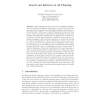Free Online Productivity Tools
i2Speak
i2Symbol
i2OCR
iTex2Img
iWeb2Print
iWeb2Shot
i2Type
iPdf2Split
iPdf2Merge
i2Bopomofo
i2Arabic
i2Style
i2Image
i2PDF
iLatex2Rtf
Sci2ools
CP
2005
Springer
2005
Springer
Search and Inference in AI Planning
While Planning has been a key area in Artificial Intelligence since its beginnings, significant changes have occurred in the last decade as a result of new ideas and a more established empirical methodology. In this invited talk, I will focus on Optimal Planning where these new ideas can be understood along two dimensions: branching and pruning. Both heuristic search planners, and SAT and CSP planners can be understood in this way, with the latter branching on variables and pruning by constraint propagation, and the former branching on actions and pruning by lower bound estimations. The two formulations, however, have a lot in common, and some key planners such as Graphplan can be understood in either way: as computing a lower bound function and searching backwards from the goal, or as performing a precise, bounded form of variable elimination, followed by backtracking. The main limitation of older, so-called Partial Ordered Causal Link (POCL) planners, is that they provide smart bra...
| Added | 29 Jun 2010 |
| Updated | 29 Jun 2010 |
| Type | Conference |
| Year | 2005 |
| Where | CP |
| Authors | Hector Geffner |
Comments (0)

